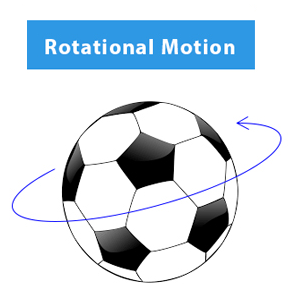Types of Motion Physics : In relation to the change in direction, there are two variables that can used to describe the change in the position. They are displacement and distance. Now the issue is what’s the difference? Talking about distance, we described as the total length covered by the movement. It can express by the magnitude. In contrast it is possible to represent displacement as the shortest distance between beginning and the end. It is dependent on both magnitude and direction to provide an accurate representation.
What is Motion?
Motion is the movement of an object in relation to time. A book falling from a table, the flow of water from the tap, windows rattling and more all show motion. The air we breathe is motion! The universe is constantly moving. We are part of a universe that is always in motion. The primary particle of matter called the atom is constantly in motion, too. Every physical activity throughout the universe is made of motion in some form. The motion could be slow or fast, however, motion is there. It is crucial to devote sufficient focus in the field of study on motion due to its significance in the world of physical.

Types of Motion Physics
As was mentioned earlier, distance and displacement used to define the shift in the position. If someone inquires about the difference in distance between B and A, we are unable to give an exact answer as it is dependent on the route chosen. It could or might not be identical for all three routes. For displacement, however it is possible to give the answer we want since the straight line connecting these two locations. Also, the term displacement is simply the distance that is the shortest between two points and in this case will be Path 2. Additionally, it follows specific directions from A to B as you can observe.
- Translatory motion
- Rotatory motion
- Vibratory motion
We now have an understanding of the basic concepts behind both the concepts; we’ll attempt to figure out an example: Let’s suppose that there is a distance of two cities A and B is called’d’. The person travels between A and B, and returns. Calculate the distance travelled and displacement.
Translatory motion
“In translational motion it is when a body moves along a line with no rotation. The line can appear straight or curved. “Watch how different objects are moving. Are they moving in a unidirectional line? Do they travel in the shape of a circle? A car that is moving along a straight line exhibits transnational motion. Similar to an airplane that is traveling directly is in translational movement. Translational motion further subdivided into circular motion, linear movement, as well as random.

Tranaslatory motion Examples
- Motion of train
- motion of earth
- motion of birds
- motion of insects
- motion of airplane
- the motion of gas molecules
Rotatory motion
“The rotation of a body around its axis is known as its “rotatory motion” Study the movement of the tap. It is spinning around an Axis. The spinning top’s particles are in circular motion, and as such the individual particles have circular motion. Does the top have circular motion?

The top rotates about its axis as it passes through it, and consequently it has a rotatory motion. Axis’s are lines that a body turns around. In a circular movement, the point around the body is not inside the body. In a rotatory movement the sole point in which a body is moving around, is moving through the body.
Rotatory motion examples
- The earth’s movement around its axis of gravity that creates night and day is known as rotatory motion.
- The wheel’s movement on its axis and the motion on the steering wheel is two examples of the rotatory motion.
Vibratory motion
“The motion of a body about its mean position is known as vibratory motion.”
Take a look at a baby’s swing, as illustrated in the figure above. When it pushed forward, the swing moves around its average position. The baby’s movement continues from one end to the other with the swing. The movement of the pendulum in an alarm clock around its average location is an excellent example of a vibrational motion.

Children playing in a see-saw are an illustration of vibrational motion.
In addition to these examples, an infant in a cradle is moving to and from, the to and from motions of the hammer in a ringing electric bell and the vibrating of the strings that plays the sitar is just a few examples of vibrational motion. The simple harmonic movement is an illustration vibrational motion.
Examples of Motions
Let us now understand motion in a clear manner with the help of couple of examples.
- Our everyday activities, such as running, walking and closing the door and so on. Involve movement. It is possible to alter the location of the object during these tasks.
- The movement of air into and out of the lung another illustration of motion.
- The vehicles that transport passengers from their point of pickup to their destination are able to move. In this instance the location of the passengers can changed from one location to the next.
Magnetic Types Materials with Examples And Properties